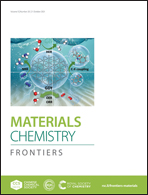Facile fabrication of CuCo2S4 nanoparticles/MXene composite as anode for high-performance asymmetric supercapacitor†
Abstract
A novel organ-like Ti3C2Tx/CuCo2S4 composite was synthesized via a hydrothermal method by forming well-defined and uniformly dispersed CuCo2S4 nanoparticles on Ti3C2Tx nanosheets. Mainly owing to the increase in conductivity, electron/ion transport capacity and the structural stability of the Ti3C2Tx/CuCo2S4 composite in 6 M KOH electrolyte, the MXene/CuCo2S4 composite material exhibited enhanced performance (992.3 C g−1 at 1 A g−1) compared with pristine CuCo2S4 (675.2 C g−1 at 1 A g−1) and Ti3C2Tx MXene (92.3 C g−1 at 1 A g−1). In addition, an asymmetric supercapacitor (ASC) was built with Ti3C2Tx MXene/CuCo2S4 as the positive electrode and activated carbon (AC) as the negative electrode (MXene/CuCo2S4//AC). This ASC device exhibited a specific capacity of 269.4 C g−1 at 1 A g−1 in the potential range from 0 to 1.6 V. The maximum specific energy of 66.8 W h kg−1 at a specific power of 895.1 W kg−1 was obtained with an 88.2% capacity retention after 10 000 charge–discharge cycles at a current density of 8 A g−1. Moreover, the ASC device also showed 89.7% capacity retention at floating time over 200 h at 8 A g−1. These results illustrate MXene/CuCo2S4 as a promising electrode for supercapacitors.



 Please wait while we load your content...
Please wait while we load your content...